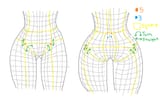Search Results
5/31/2025, 12:15:40 PM
>>1012911
5s and even 6s are necessary to make just about anything. Because they're how you "turn" loops. I need the loops to turn, so I create a 5 that allows turning. Simple necessity dictates its existence.
5 way poles are not going to cause harm to shading. The disadvantage with 5s, is that 1 vert dictates the volume of that area. So a 5 area might appear flatter in locations that required fullness.The trick is to place them into relatively flat areas, where the edges will be mostly spread out evenly. Or inside of creases where the edges will get tucked.
So in the image, the 5s are placed along the crease lines. Where I expect the groin area to crease in the front, and where the butt is expected to crease in the back. Perhaps I could have made the back crease lower. But, eh.
From my testing, 3s are the ones that fuck up shading. You don't want 3s on convex surfaces at all. That's mainly what my topology avoids. A lot of tutorials place 3s on the butt area, because they want that fullness when the leg bends. But if you set up the butt just so, then you can get the fullness without 3s fucking up the shading. Here, the 3s are on the "inside", the concave part of the ass, along the inner crack. They will be hidden away there.
You can't get around using 3s or 5s. It's actually impossible. You have to turn loops to make smooth topology. When you turn a loop, you create a 5. And when you create a 5, it has to be resolved by a 3 somewhere. Don't ask me how it works, it's just the laws of math and topology. Best not to worry about them too much. Except try to keep 3s away from convex surfaces if you can.(Unless you just need a corner.)
Hard surfaces can handle 5s too. But I'm less experienced with hard surface modelling, so I don't feel like I can speak with authority there. Only that if you look around, you will see 5s in the work of professionals. Because it's unavoidable.
5s and even 6s are necessary to make just about anything. Because they're how you "turn" loops. I need the loops to turn, so I create a 5 that allows turning. Simple necessity dictates its existence.
5 way poles are not going to cause harm to shading. The disadvantage with 5s, is that 1 vert dictates the volume of that area. So a 5 area might appear flatter in locations that required fullness.The trick is to place them into relatively flat areas, where the edges will be mostly spread out evenly. Or inside of creases where the edges will get tucked.
So in the image, the 5s are placed along the crease lines. Where I expect the groin area to crease in the front, and where the butt is expected to crease in the back. Perhaps I could have made the back crease lower. But, eh.
From my testing, 3s are the ones that fuck up shading. You don't want 3s on convex surfaces at all. That's mainly what my topology avoids. A lot of tutorials place 3s on the butt area, because they want that fullness when the leg bends. But if you set up the butt just so, then you can get the fullness without 3s fucking up the shading. Here, the 3s are on the "inside", the concave part of the ass, along the inner crack. They will be hidden away there.
You can't get around using 3s or 5s. It's actually impossible. You have to turn loops to make smooth topology. When you turn a loop, you create a 5. And when you create a 5, it has to be resolved by a 3 somewhere. Don't ask me how it works, it's just the laws of math and topology. Best not to worry about them too much. Except try to keep 3s away from convex surfaces if you can.(Unless you just need a corner.)
Hard surfaces can handle 5s too. But I'm less experienced with hard surface modelling, so I don't feel like I can speak with authority there. Only that if you look around, you will see 5s in the work of professionals. Because it's unavoidable.
Page 1
